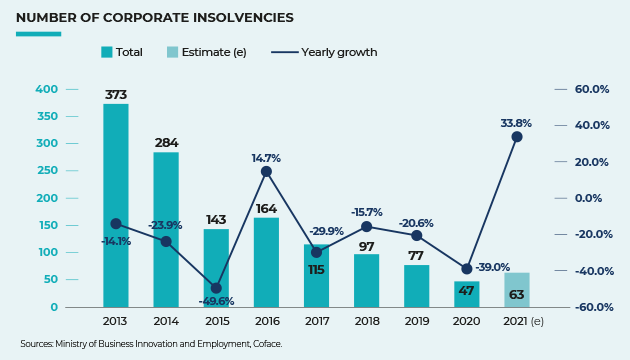

New Zealand
Synthesis
MAJOR MACRO ECONOMIC INDICATORS
| 2020 | 2021 | 2022 (e) | 2023 (f) | |
|---|---|---|---|---|
| GDP growth (%) | -2.1 | 5.6 | 2.3 | 0.8 |
| Inflation (yearly average, %) | 1.7 | 3.9 | 7.2 | 5.1 |
| Budget balance (% GDP) | -7.2 | -1.3 | -2.7 | -1.6 |
| Current account balance (% GDP) | -0.8 | -6.0 | -7.7 | -6.0 |
| Public debt (% GDP) | 43.2 | 50.8 | 56.6 | 58.6 |
(e): Estimate (f): Forecast *Fiscal year 2023: July 2022-June 2023
STRENGTHS
- Proximity to Asia and Australia
- Attractive tourist destination
- Large and competitive agricultural sector (world’s leading exporter of dairy products)
- Free trade agreements; that signed with the EU will enter into force by end of 2024
- Limited public debt
- High quality of life
- Excellent business environment
WEAKNESSES
- Island nation
- Reliance on foreign capital
- High levels of household debt (particularly for housing, where supply is in short supply) and business debt (particularly in agriculture)
- Reliance on Chinese demand (accounts for 29% of goods exports)
- Shortage of skilled labour
- Lack of R&D and low labour productivity growth compared to other OECD countries
- Vulnerable to natural hazards, environmental issues linked to the significance of the intensive agriculture
- Dependence on immigration
- Socio-economic inequalities between Maoris and non-Maoris
RISK ASSESSMENT
Durably gloomy economic environment
The Kiwi economy has been hit hard by multiple headwinds including high inflation, elevated interest rates and a property market downturn which prompted the country to post slower GDP growth in 2023, with a technical recession in the first quarter of the year and possibly in the fourth quarter. In 2024, New Zealand will continue to face challenges that will result in ongoing muted growth. While inflation will stay on a downward trend, it will remain higher than in pre-pandemic years, due in part to durably rapid wage growth and a migration-induced increase in rents. Despite expected household tax cuts by the new Luxon government, persistently elevated inflation would erode further improvement in consumer confidence, which was low throughout 2023 compared to historical values. Consequently, private consumption (56% of GDP) is likely to post tepid growth. In addition, property prices are not expected to markedly recover after their fall over 2022 and the beginning of 2023 amid high interest rates. This would continue to affect household wealth. The Reserve Bank of New Zealand (RBNZ), which took the policy rate to 5.5% in May 2023, a level not seen since 2008, communicated its plan to maintain the status quo in 2024 which would also limit private consumption owing to the high level of household indebtedness (170% of disposable income in 2022). High interest rates will also weigh on private investment. On the public side, investment will be boosted by heavy infrastructure spending, notably related to transport and education. Export growth, while limited by mild global demand especially from the country’s top partners China (29% of total exports), Australia (11%), and the US (11%), will benefit from robust demand for food, with dairy products and meat representing the two largest export items in value (30% and 14% of total exports, respectively). Service exports would be lifted by the recovery of tourism (14% of GDP in 2019). International tourist arrivals represented 73% of 2019 levels over January-October 2023.
Agriculture (5% of GDP) will continue to enjoy the return of migrant workers (around 20% of the sector’s workforce in 2019) and is likely to benefit from the government formed in October 2023 after years of public policies introduced by the Labour Party aimed at reducing the sector’s impact on biodiversity and global warming.
Current account remains notably imbalanced
The fiscal deficit for the year ending in June 2024 is expected to increase slightly. Although most of the Covid-related support measures have been lifted, expenditure will remain high, reflecting the government’s long-term aid in response to the North Island weather events of early 2023 and the increasing cost of debt servicing amid higher interest rates. Tax revenue was also revised downward amid lower economic growth. Over the longer term, the government expects the deficit to gradually reduce as of 2024 before posting surpluses from 2026-2027. It plans to do so by expenditure cuts, putting an end to spending associated with the 2023 weather-related events, scrapping free early childcare education and funding for public transport improvements. Improved economic performance would also contribute by boosting revenue.
The current account deficit is expected to keep narrowing in 2024. The trade deficit will continue to remain sizeable, with exports affected by sluggish global demand and import costs driven by durably elevated energy prices. In addition, the structural deficit in the income account balance, mostly related to debt servicing costs (external debt accounted for 87% of GDP in 2022) should also continue to weigh. The current account reduction would therefore be mainly explained by a smaller deficit in the services balance, which is set to continue shrinking on back of the recovery of inbound tourism. The current account deficit is traditionally financed by financial and capital inflows, both in the form of direct and portfolio investments. Foreign reserves which represented around three months of imports in 2022, may also contribute to the financing. Risks relating to a possible depletion of the international reserves are limited as the country’s external debt is mainly denominated in local currency.
Politics veer to the right
While polls had suggested that the previous Prime Minister Chris Hipkins’ popularity was shaky after he took office in the wake of Jacinda Ardern’s resignation in January 2023, he was still the preferred choice as PM over Christopher Luxon, leader of the centre-right National Party in September of the same year. Nevertheless, polls had also revealed that the population favoured the latter party over the ruling Labour Party. The general elections held in October 2023 resulted in Hipkins losing the absolute majority. Furthermore, the National Party became the largest party in Parliament by securing 48 of the 122 seats. Short of the 62 seats needed to govern as an outright majority, a coalition agreement between the incoming PM’s National Party, the right-wing ACT, and the populist and centrist New Zealand First parties was reached after talks lasting several weeks.
On the diplomatic scene, US-China rivalry poses challenges to New Zealand. Washington is a long-standing diplomatic ally and security alliance partner. Meanwhile, Beijing is by far the largest destination of New Zealand’s exports. In a bid to maintain a good relationship with both countries, former PM Hipkins visited China in June 2023. Nevertheless, the appointment as foreign minister of Winston Peters, leader of New Zealand First and a critic of Beijing, may cool the relationship between the two countries.
Last updated: February 2023
Payment
Primary payment methods in New Zealand consist of card (debit card and credit card) and electronic credit or debit (direct debits and credits, automated bill payments and electronic transfers). There has been a rapid increase in the use of contactless payments, mobile phone-based applications, and payments using the internet. Although cash remains important, its use is reducing significantly and cheque usage halved between 2013 and 2016. Wire transfers and SWIFT bank transfers are the most commonly used payment methods for domestic and international transactions. Most of New Zealand’s banks are connected to the SWIFT network.
Debt Collection
The debt collection process usually begins with serving a letter of demand, where the creditor notifies the debtor of their payment obligations (including any contractual interest due) with a time limit for making the payment.
Summary judgment proceedings
If the creditor does not receive payment after issuing a letter of demand, a next possible step is to issue summary judgment proceedings. This procedure is intended for situations where the debtor has no defence against the claim. An application can be made to the District Court or High Court, depending on the value of the claim. The District Court has jurisdiction to hear matters for claims up to NZD 350,000, and the High Court typically hears matters for claims above NZD 350,000. A statement of claim must be filed, along with a notice of proceedings, an application for summary judgment and a supporting affidavit by the creditor (or in the case of a company, an individual with personal knowledge of the facts who is authorised to submit an affidavit on behalf of the company), which sets out the facts of the claim. A summary judgment typically involves a hearing, which lasts around one day (if the debtor raises a defence), with evidence given by way of affidavit rather than requiring witnesses. If the application is successful, the Court may enter a judgment in favour of the creditor. If the application is undefended, judgment may be entered by default in favour of the creditor, without the need for a full hearing although an appearance in Court to call the matter will be required. If the defendant is able to show an arguable defence, the Court may decline summary judgment and direct the matter to be heard as an ordinary proceeding.
Ordinary proceedings
Ordinary proceedings are used where summary judgment is unavailable because the debtor has raised a genuine defence, or if summary judgment is not granted. Ordinary proceedings are initiated by filing a notice of proceeding and a statement of claim. Depending on the value of the claim (as outlined above), these proceedings can take place in the District Court or the High Court. Unlike summary judgment, an ordinary defended proceeding may involve additional processes, such as discovery, hearing of evidence and interlocutory applications, or serving of briefs of evidence, depending on the nature of the proceeding.
Appeals
The High Court determines appeals from the District Court. The Court of Appeal has jurisdiction to hear appeals from the High Court. Appeals are generally restricted to questions of law only. Appeals to the highest appellate court in New Zealand, the Supreme Court, can only be heard with leave of that Court. Leave will be granted if the Supreme Court is satisfied that it is necessary in the interests of justice to hear the appeal.
Enforcement of a Legal Decision
If the Court enters judgment in favour of the creditor, there is no appeal, or all appeal avenues have been exhausted, the creditor can apply to the High Court, or District Court (depending on the value of the claim as outlined above), seeking enforcement action. This can include a deduction from the debtor’s wages or benefits (if the debtor is an individual), seizure of property, garnishee proceedings, or placing a charge on the debtor’s property.
Foreign judgments must first be recognised by the Court under the Reciprocal Enforcement of Judgments Act 1934, or common law.
Insolvency Proceedings
Bankruptcy
If the creditor does not receive payment after obtaining judgment against a debtor and that debtor is an individual, the creditor can issue a bankruptcy notice served on the debtor. Failure by the debtor to comply with a bankruptcy notice is considered by the law to be an act of bankruptcy.
Statutory demand
If the debtor does not make payment pursuant to the letter of demand and that debtor is a company, a further potential step is for the creditor to prepare and serve a statutory demand for the outstanding debt. This can be used as an alternative to summary judgment or ordinary proceedings. A statutory demand can only be issued if there is no substantial dispute over the debt. Once the statutory demand is served on the debtor, the debtor has 15 working days to pay the debt, or to enter into an arrangement for payment which is agreed by the creditor. If the debtor company does not make payment pursuant to the statutory demand, the creditor has a further 30 working days to commence liquidation proceedings against the debtor company, using non-compliance with the statutory demand as evidence of the debtor’s inability to pay its due debts. However, a debtor company can make an application to set aside a statutory demand within 10 working days of being served with it. The Court may set aside the statutory demand if there is a substantial dispute as to whether or not the debt is due, if the debtor company has a counterclaim, set-off or cross-demand, or if there are other adequate grounds to do so.
Liquidation
Liquidation involves the realisation and distribution of a debtor company’s assets when the company is insolvent, or does not expect to remain in business. A liquidator is appointed to the company, who takes over the management of the company, realises its assets, pays its creditors and distributes the remainder to its shareholders.
Creditors’ compromise
There are two potential forms of creditors compromise, either an informal agreement between debtor and creditor, or a formal creditors’ compromise under the Companies Act 1993. A formal creditors’ compromise is a binding agreement between a debtor company and its creditor(s) regarding the payment of its debts, with terms and conditions that are less exacting than the strict legal rights of creditors. A compromise may involve payments over time, deferred payments, or accepting a lesser sum in full and final settlement of the debt. Once a creditors’ compromise is approved by the required majority of creditors, or the Court, the compromise binds all creditors. An equivalent procedure exists for individuals under the Insolvency Act 2006.
Voluntary administration
The debtor company may go into voluntary administration to try and maximise the chances of an insolvent company continuing to operate, or if that is not possible, to allow for a better return for creditors than immediate liquidation. It enhances the existing creditors’ compromise procedure as an alternative to liquidation, by imposing a moratorium on creditors taking steps to enforce their debts.
Business Debt Hibernation
The business debt hibernation is a scheme established to help businesses affected by COVID-19. It enables businesses to gain protection from debt recovery actions for a month while they negotiate with creditors, and a further six months’ protection if creditors agree to an arrangement for repayment. The scheme has a number of conditions that must be fulfilled before a business can enter business debt hibernation.
Other alternative processes
The Disputes Tribunal conducts an informal and confidential process run by a referee to encourage both sides to reach an agreement, or make a binding decision if both sides cannot agree. At the first instance, this is typically a less costly option, as it avoids lawyers. However, the Disputes Tribunal can only hear claims for disputed debts of below NZD 15,000 or, if both parties agree to extend the financial limit, of up to NZD 20,000.
Arbitration or mediation (often less expensive than court proceedings) may also be used to resolve disputes and obtain more rapid out-of-court settlements.





